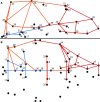Genetics of murine craniofacial morphology: diallel analysis of the eight founders of the Collaborative Cross
- PMID: 26426826
- PMCID: PMC4694168
- DOI: 10.1111/joa.12382
Genetics of murine craniofacial morphology: diallel analysis of the eight founders of the Collaborative Cross
Abstract
Using eight inbred founder strains of the mouse Collaborative Cross (CC) project and their reciprocal F1 hybrids, we quantified variation in craniofacial morphology across mouse strains, explored genetic contributions to craniofacial variation that distinguish the founder strains, and tested whether specific or summary measures of craniofacial shape display stronger additive genetic contributions. This study thus provides critical information about phenotypic diversity among CC founder strains and about the genetic contributions to this phenotypic diversity, which is relevant to understanding the basis of variation in standard laboratory strains and natural populations. Craniofacial shape was quantified as a series of size-adjusted linear dimensions (RDs) and by principal components (PC) analysis of morphological landmarks captured from computed tomography images from 62 of the 64 reciprocal crosses of the CC founder strains. We first identified aspects of skull morphology that vary between these phenotypically 'normal' founder strains and that are defining characteristics of these strains. We estimated the contributions of additive and various non-additive genetic factors to phenotypic variation using diallel analyses of a subset of these strongly differing RDs and the first eight PCs of skull shape variation. We find little difference in the genetic contributions to RD measures and PC scores, suggesting fundamental similarities in the magnitude of genetic contributions to both specific and summary measures of craniofacial phenotypes. Our results indicate that there are stronger additive genetic effects associated with defining phenotypic characteristics of specific founder strains, suggesting these distinguishing measures are good candidates for use in genotype-phenotype association studies of CC mice. Our results add significantly to understanding of genotype-phenotype associations in the skull, which serve as a foundation for modeling the origins of medically and evolutionarily relevant variation.
Keywords: collaborative cross; craniofacial form; diallel; micro-computed tomography; morphometrics; mouse models; normal variation.
© 2015 Anatomical Society.
Figures







References
-
- Abzhanov A, Tabin CJ (2004) Shh and Fgf8 act synergistically to drive cartilage outgrowth during cranial development. Dev Biol 273, 134–148. - PubMed
-
- Abzhanov A, Protas M, Grant BR, et al. (2004) Bmp4 and morphological variation of beaks in Darwin's finches. Science 305, 1462–1465. - PubMed
-
- Abzhanov A, Kuo WP, Hartmann C, et al. (2006) The calmodulin pathway and evolution of elongated beak morphology in Darwin's finches. Nature 442, 563–567. - PubMed
Publication types
MeSH terms
Grants and funding
LinkOut - more resources
Full Text Sources
Other Literature Sources
Molecular Biology Databases
Miscellaneous

